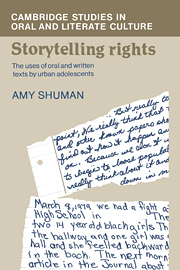Book contents
- Frontmatter
- Contents
- Acknowledgments
- Introduction
- 1 Fight stories: what counts is the recounting
- 2 Storyability and tellability
- 3 Collaborative uses of literacy in the adolescent community
- 4 Retellings
- 5 Varieties of contextuality
- 6 Familiarity and distance: toward a theory of oral and written personal narration
- Notes
- Bibliography
- Index
5 - Varieties of contextuality
Published online by Cambridge University Press: 05 November 2011
- Frontmatter
- Contents
- Acknowledgments
- Introduction
- 1 Fight stories: what counts is the recounting
- 2 Storyability and tellability
- 3 Collaborative uses of literacy in the adolescent community
- 4 Retellings
- 5 Varieties of contextuality
- 6 Familiarity and distance: toward a theory of oral and written personal narration
- Notes
- Bibliography
- Index
Summary
The rules for determining who is entitled to tell what to whom are not explicit but are based upon a continual process of building shared understandings. Shared understandings involve contextual relationships both between addressors and addressees and between revealed and concealed messages. It is especially important that these two contextual relationships be considered together in discussions of oral and written communication in order to avoid the false assumption that writing always serves to present explicit (revealed) messages to distant readers.
Literacy scholarship has often made the mistake of discussing only information, or revealed messages. Scholars have focused on how written communication makes information available to distant readers, and they have argued that writing provides contextual details that are often unnecessary in face-to-face communication. Although the distinction between distant writers and proximate speakers is sometimes valid, it cannot account for the familiarity or distance created by specialized written communications, collaborative writing, concealed oral messages, or diary entries. Familiarity and distance depend not only on the appropriate use of contextual details but also on the relationship between addressor and addressee and on the use of messages to reveal or conceal information.
The appropriate use of contextual details follows certain conventions, and one way of defining distant and proximate communications is to state that distant communication requires that conventions be standardized enough to be shared among people far removed from each other in space, time, or social status, whereas proximate communication relies upon local conventions.
- Type
- Chapter
- Information
- Storytelling RightsThe Uses of Oral and Written Texts by Urban Adolescents, pp. 152 - 182Publisher: Cambridge University PressPrint publication year: 1986



